Haiderpur: A Paradise Along The Mighty Ganga
First published in Sanctuary Asia,
Vol. 42
No. 12,
December 2022
By Manisha Bisht, Rounak Patra, Sipu Kumar and Amit Kumar
The sun shone bright on a chilly winter morning as we walked briskly past a wooden sign swaying in the breeze. We were entering the Haiderpur wetland. Excited by what lay ahead – a panoramic view of lush green vegetation, birdsong and an undulating gleaming waterbody, we felt that we were privy to a little-known emerald secret of the Ganges. Since the dawn of history, the mighty river has been sacred to the people of the sub-continent. Originating from Gaumukh, at the base of the Gangotri glacier and coursing its way across several northern states of India to finally surrendering itself to the Bay of Bengal, the Ganges has shaped large floodplains, including major wetlands and deltas. As the river crafted its path, it gave rise to habitats that supported an abundance of flora and fauna. With a drainage area of 862,796 sq. km., the Ganges is home to more than a hundred floodplain wetlands, that are considered some of the most fertile regions in India.
Haiderpur, one of the largest of these floodplain wetlands took shape after the formation of the Bijnor Barrage in 1984. We had the opportunity to explore this magnificent self-sustained, backwater-recharged wetland between 2020 and 2021. Though the wetland stretches over an area of 30,000 acres with a core area of 12,000 acres forming a part of Hastinapur Wildlife Sanctuary, a cursory view from the barrage, does little to intrigue the visitor. Perhaps it is this uninspiring shape that has concealed it from human greed. Nevertheless, as one begins exploring the wetland, its wonders only increase. A diversity of habitats ranging from deep upstream reservoirs to shallow flooded lands, islands and river stretches, Haiderpur offers sustenance and shelter to varied aquatic and terrestrial flora and fauna, supporting more than 20,000 birds from 300 avian species every year including the Lesser-Whistling Duck, Bronze-winged Jacana and Sarus Crane and species such as the swamp deer and gharial. Amidst large trees that grow along the mighty river, are shrubs, herbs and several species of grasses, reeds and sedges. The waterscape includes aquatic floating, aquatic submerged, roadside, islands and riverbanks that harbour one or more species of Typha, Phragmites, Saccharum, Ipomoea, Nelumbo, Nymphaea, Eurayle, Pistia and Eichhornia. This wetland, recently nominated as a Ramsar Site, is known to locals as the ‘Barrage Wali Jheel’ and is undoubtedly a textbook description of the northern Gangetic plains portrayed in Hindi folklore.
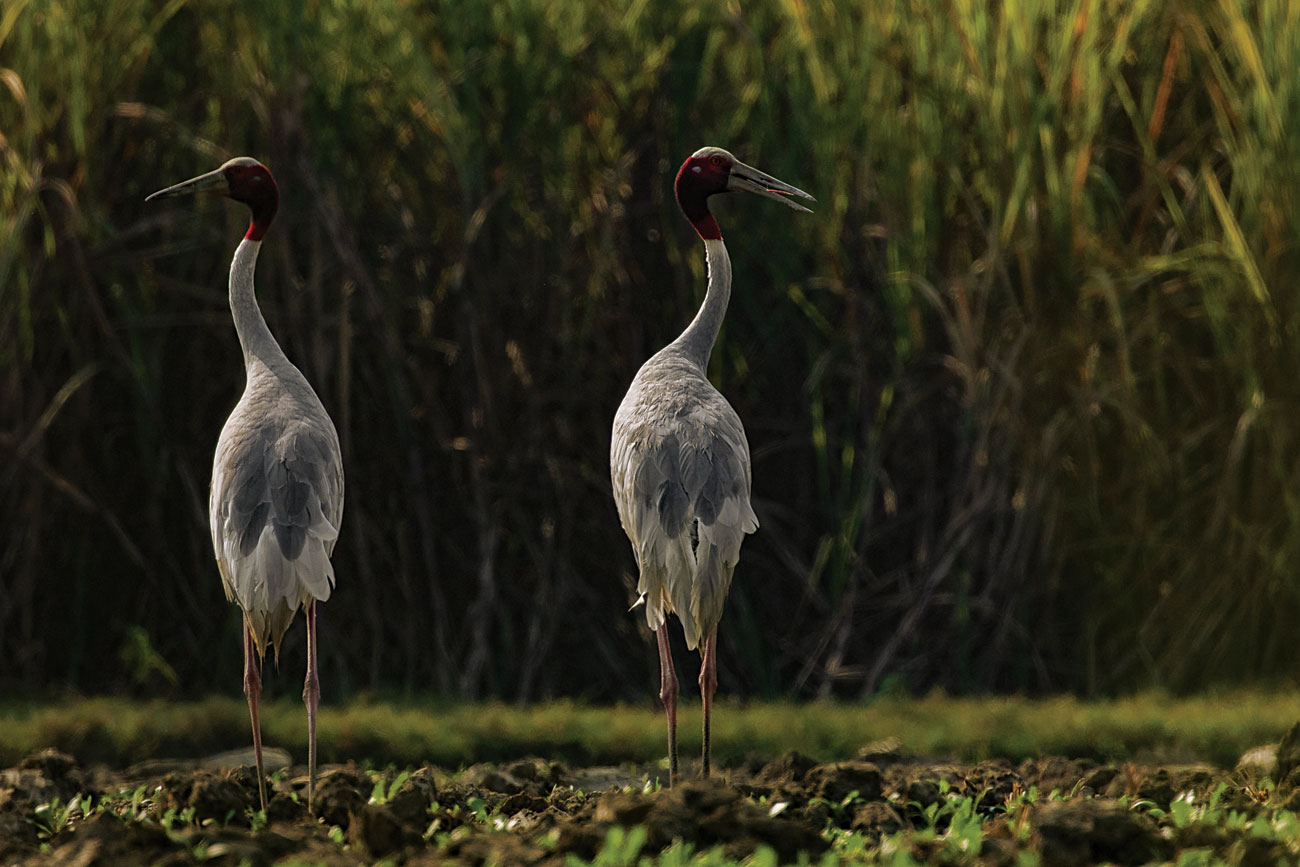
A Sarus Crane Grus antigone pair near an agricultural field adjacent to the Haiderpur wetland. Photo: Swaroop Singha Roy.
Exploring Haiderpur
As we moved past the entrance, we discovered that the area has a 15 km. long trail with observatory huts at every half kilometre. Visitors can rent a bicycle and ride along the entire trail. A shorter trail that ends in a double-storied watchtower – an ultimate vantage point, which offers a view of a majority of the wetland, is also an option. From the watchtower, we watched the wetland filled with the cacophony of Eurasian Coot, with diving Dabchicks in the middle and a huge congregation of Greylag Geese. The wetland’s peripheries were wreathed with water hyacinth where Grey-headed Swamphens and Egrets hunted for food. A Large-billed Crow circumnavigated the watchtower, showing its displeasure by calling raucously, possibly irked by human presence.
When we repositioned our binoculars, we were fortunate to see a herd of swamp deer moving in a relaxed fashion, grazing through the wetland. The state animal of Uttar Pradesh, and confined to the Indian subcontinent, it is listed as ‘Vulnerable’ in the IUCN Red List, with just three sub-species existing and populations completely wiped out from Pakistan and Bangladesh. A handful inhabit the stretches of Terai floodplains, Central India and Northeastern India. The Haiderpur wetland is one of those few places outside Protected Areas in India that supports a healthy swamp deer population. Commonly referred to as ‘barasingha’, (‘twelve-tined’) these niche-specific megaherbivores are obligate grassland-dwelling organisms. While these cervids are excellent ecosystem managers with their ability for effective seed dispersal and nutrient recycling within grasslands and wetlands, the hunting of these herbivores for their antlers, meat and skin, followed by the degradation and fragmentation of tall grassland habitats such as Haiderpur, are some of the many threats they face. Their unique habitat requirement and slow birth rate further add to their woes. This makes them a high priority species for conservation in areas like Haiderpur, where efforts towards their protection are still in the preliminary phase. While a small part of the wetland does come under the jurisdiction of the Hastinapur Wildlife Sanctuary, most of the area is still not secure.
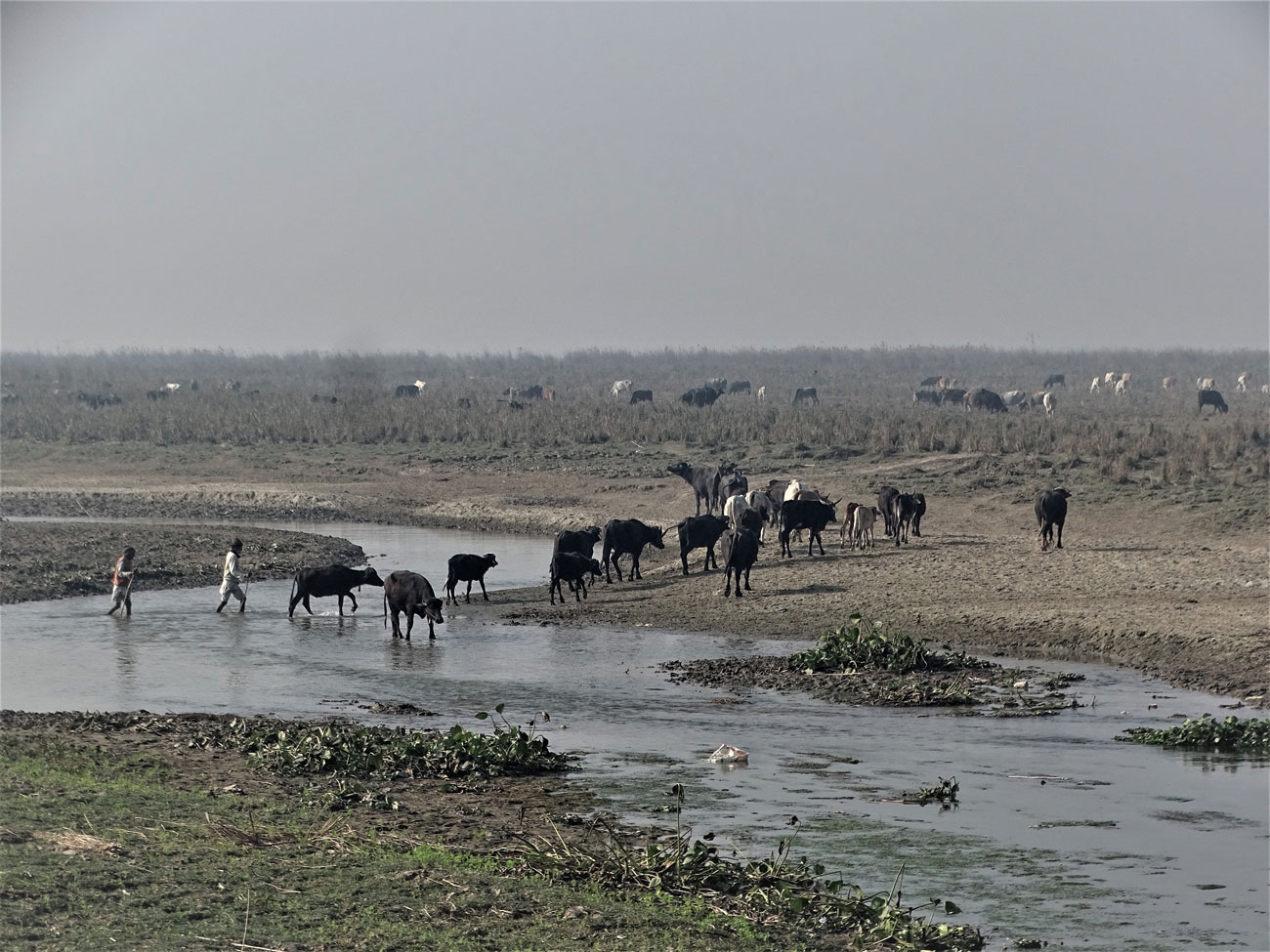
With agricultural lands expanding closer and closer to the Haiderpur wetland, grazing and other human interference in the form of egg theft and hunting pose a significant threat here. Photo: Amit Kumar.
Surveying The Wetland
During our village surveys, while wandering through agricultural land, a pair of Sarus Cranes enthralled us. The cranes, known for their fidelity and exquisite courtship behaviour, which includes trumpeting calls and wing displays, seemed unaware of our presence and continued feeding.
As with the swamp deer, Sarus Cranes are another niche specific species that largely prefer agricultural lands around wetlands for their survival and breeding. With global populations decreasing at an alarming rate, making the species ‘Vulnerable’, wetlands such as Haiderpur could play a major role in their conservation. However, with agricultural lands expanding closer and closer to the wetland, human interference in the form of egg theft and hunting pose a significant threat here.
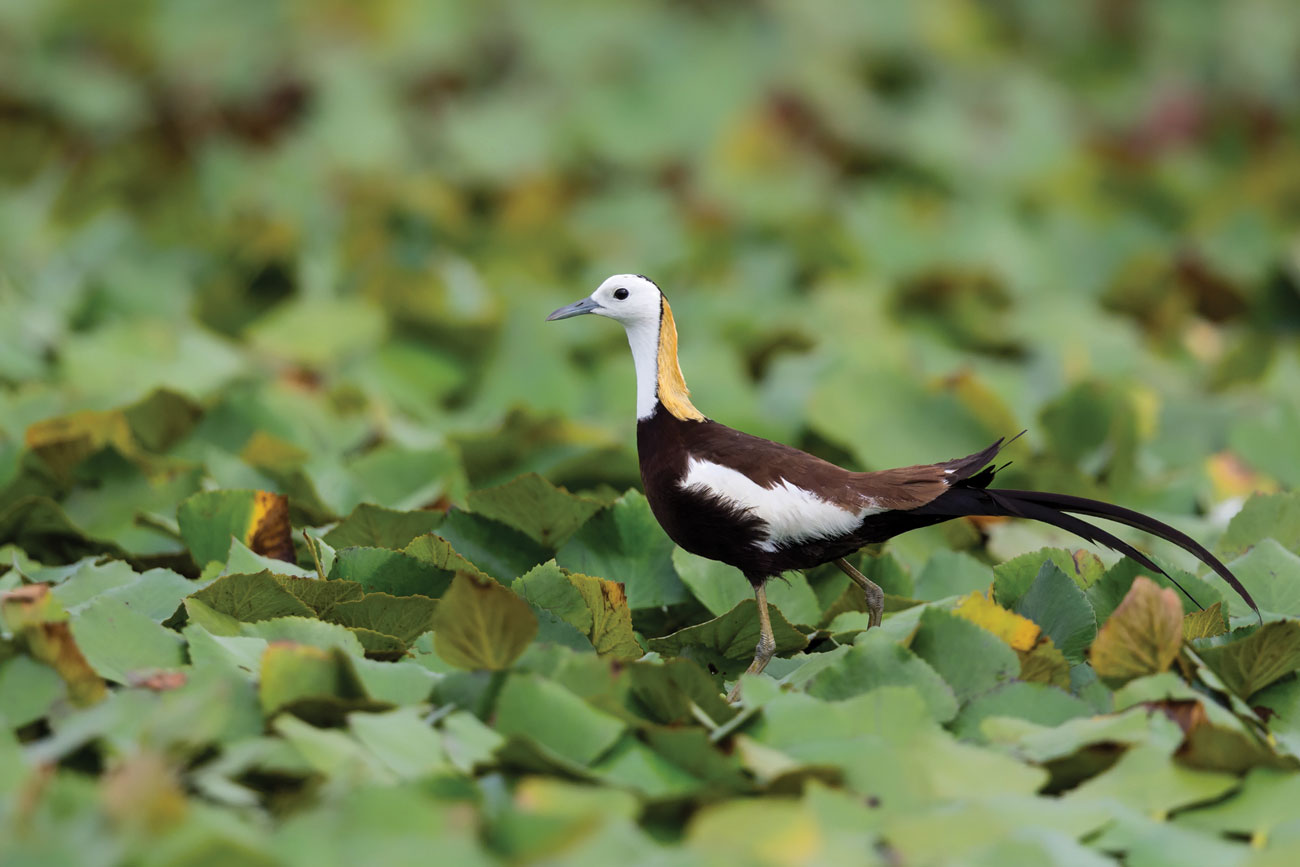
A Pheasant-Tailed Jacana Hydrophasianus chirurgus on Trapa nutans, a commercial crop grown around the Haiderpur wetland. Photo: Arindam Bhattacharya.
During our surveys in and around the wetland, we recorded varied mammals, reptiles and amphibians and of course rich avian life. This included the Indian golden jackals, Indian rock pythons, otters and turtles. A staggering number of Greylag Geese possibly one of the largest congregations in the country, followed by Knob-billed Ducks Sarkidiornis melanotos and other groups of Anatidae kept us enthralled. With winter migration at its peak, the insectivorous Citrine Wagtails Motacilla citreola, were seen in large numbers. Bar-headed Geese Anser indicus, the world’s highest-flying birds, were abundant. On foggy days, despite being well-equipped with gadgets and high enthusiasm, we failed to locate any birds and shifted our timings of bird surveys to afternoons. Accordingly, a slight shift in sightings was evident, with more active Woolly-necked Storks Ciconia episcopus and Black-headed Ibises Threskiornis melanocephalus being spotted. Raptors such as the Greater Spotted Eagle Clanga clanga and Eurasian Marsh Harrier Circus aeruginosus were seen soaring over the wetland. From common wetland birds like sandpipers, jacanas and swamphens foraging near the shallow waterbodies to migratory waterbirds including Northern Shovelers Spatula clypeata, Northern Pintails Anas acuta and Green-Winged Teals Anas crecca, we were elated by the wetland’s capacity to sustain such a wide range of avifauna.
From the sight of over 200 Red-crested Pochard Netta rufina roosting on sand bars, to watching the peculiar feeding behaviour of Common Pochards Aythya farina, Ferruginous Duck Aythya nyroca, and Painted Storks Mycteria leucocephala, life in the wetlands was full of learning and new experiences. Threatened species including the Black-bellied Tern Sterna acuticauda, Indian Grassbird Graminicola bengalensis and Eurasian Curlew Numenius arquata were important observations that further proves the importance of this wetland. Furthermore, several encounters with Asian water monitors, snakes and other reptiles kept our adrenaline pumped during our regular field survey.
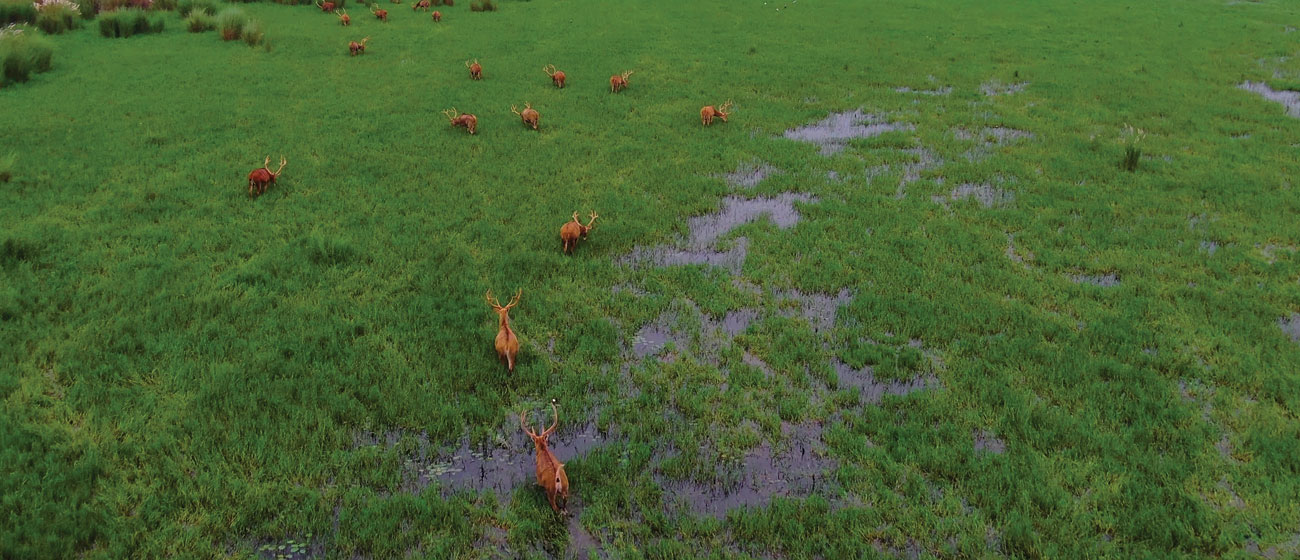
Haiderpur offers sustenance and shelter to varied aquatic and terrestrial flora and fauna, supporting more than 20,000 birds from 300 avian species and species such as the swamp deer Rucervus duvaucelii. Photo: Ravindra Nath Tripathi.
Timely Interventions
Despite sustaining such varied flora and fauna, the Haiderpur wetland was neglected for a long period before the Forest Department, under the joint jurisdiction of the Muzzafarnagar and Bijnor forest divisions, brought it under wing. In the past, the unsustainable collection of grass and reed as fodder by locals hampered growth and timely regeneration. Excessive livestock grazing, encroachment of the marshlands for commercial cultivation of Trapa natans, growth of invasive species (water hyacinth Eichhornia crassipes, water cabbage Pistia stratiotes, pink morning glory Ipomoea carnea and alligator weed Alternanthera philoxeroides) all posed a substantial threat towards prime waterfowl habitat. Bordered by nine villages, the wetland area popularly known as jheel, was used for fishing by locals. Turtles and waterfowls often got entangled in fishing nets, which were sometimes discarded as waste. However, since 2019, the active involvement of the respective forest divisions, government authorities, and NGOs such as WWF-India, individual efforts and mass awareness programmes led by birdwatchers and naturalists have led to the area being under surveillance and receiving necessary protection. While illegal fishing, wildlife poaching, unregulated resource consumption, and brewing of illegal alcohol are still rampant, the most serious threats remain expansion of the agricultural area, fragmentation of the wetland, as well as use of pesticides and fertilisers. Forest officials are working to minimise these threats with adequate management measures such as social awareness, providing alternative livelihoods to the locals, enhancing citizen science activity, removal of weeds via mechanical machines, and joint patrolling. With the introduction of e-rickshaw, natural trails and watch huts, the respective Forest Departments have been working diligently to monitor the wetland area by creating and updating checklists of faunal diversity with the support of local naturalists.
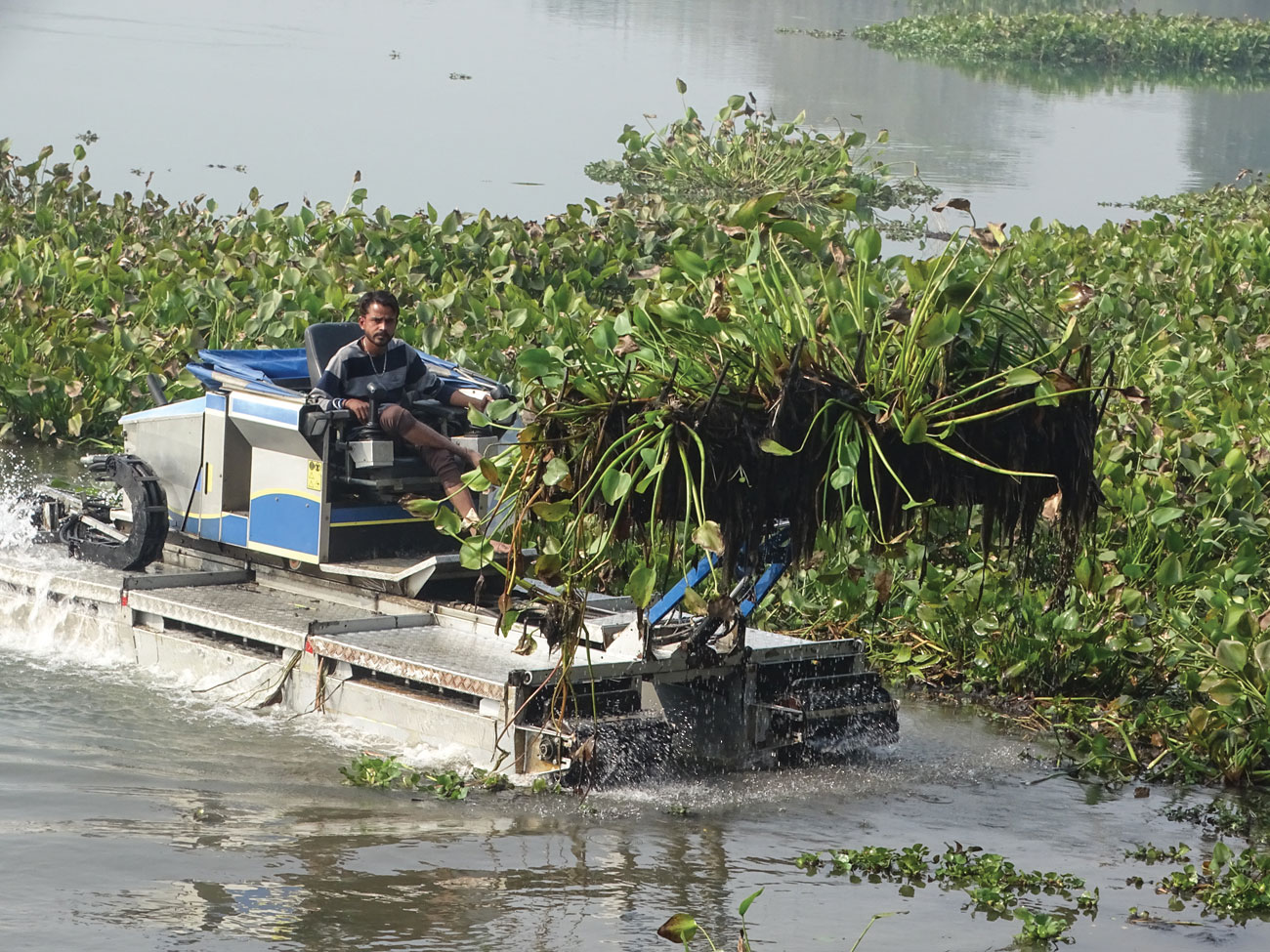
Mechanical removal of Eichhornia crassipes by the Muzaffarnagar Forest Department. Photo: Amit Kumar.
To understand the perspective of the villagers, we further visited wetland-dependent villages to undertake socio-economic surveys on their livelihood dependence and how declaring the wetland as a Protected Area or a Ramsar Site can potentially affect their livelihood. On interacting with local inhabitants, we received mixed responses; with some community members comprising fishermen and wood collectors expressing unhappiness about few initiatives. Local NGOs and Forest Departments are trying to solve their grievances through various alternate livelihood programmes and trainings, including skill-building to be a tourist guide, boat safari operator, sewing and handicraft, technical work, and through organising bird festivals and Wetland Day celebrations. However, the government’s intervention for enforcement of control over land encroachment, extensive fishing, unregulated agricultural practices, and water pollution is urgently required for the protection of faunal diversity.
Haiderpur is a wetland of paramount importance that has sheltered swamp deer, Sarus Cranes, Black-bellied Terns, and more species. It requires our attention and care and our promise that we will safeguard this wild haven for posterity.
Manisha Bisht is passionate about birds and their behaviour and has worked at the Wildlife Institute of India (WII), Dehradun, on avian behavioural ecology. Rounak Patra is an avid birdwatcher, photographer and travel blogger, currently working with the WII. His current research interests include understanding community ecology of birds and their interaction with environmental changes. Sipu Kumar is a Ph.D. Scholar at WII. His work on frugivore birds focuses on bird and plant interaction in the Shiwalik hills. Dr. Amit Kumar is a faculty at the WII. He has been exploring Himalayan regions in terms of eco-floristics for more than a decade. His research involves understanding vegetation patterns, plant associations and plant invasion ecology.






